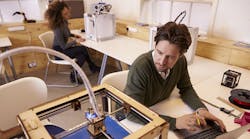3D Printing Presents Health Risks: Tips on Protecting Your Workers
3D printing, or additive manufacturing, is becoming more of a staple in the manufacturing process every day. Its presence isn’t limited to simply printing plastics and sheets of metal; manufacturers are relying on 3D printing to completely transform the process of prototyping and production.
However, with every great innovation comes consequences.
Chemical Insights, an institute of Underwriters Laboratories, and Georgia Institute of Technology (Georgia Tech) found that many desktop 3D printers, while in operation, generate ultrafine particles (UFPs) and numerous volatile organic compounds (VOCs) that may affect human health.
UFPs can be inhaled and penetrate deep into the human pulmonary system, triggering lung irritation, respiratory and chest discomfort, and asthma. Long-term exposure may lead to respiratory and cardiovascular diseases. VOC exposure can result in headaches, eye and nose irritation, and flu-like symptoms. These health concerns are especially noteworthy when 3D printers are used in small or poorly-ventilated rooms — such as small workshops or individual workstations — and large industrial spaces with multiple print units in operation and insufficient ventilation control.
Filaments, Emissions and Toxicity
Let’s dive a little deeper into the different types of 3D printer filaments, as they are a critical variable in the emissions produced and the toxicity of those emissions. Most of these are thermoplastics of known chemical content, but additives and manufacturing impurities may be present. Research has shown a range of VOCs associated with filaments:
- Acrylonitrile butadiene styrene (ABS) filaments have been found to emit over 175 different VOCs, including carcinogens like styrene and methylene chloride.
- Polylactic acid (PLA) filaments have produced over 50 identified VOCs, including 1-Butanol which can affect the eyes, skin, respiratory and central nervous systems. However, PLA has a considerably lower emission rate than its counterparts.
- Nylon filaments emitted a range of different low-level VOCs. Over 90% of the volatile emission content is caprolactam that can affect the eyes, skin, liver, kidney and respiratory, cardiovascular and central nervous systems.
Clearly, VOC emission compositions and total VOC emission levels depend on filament material. ABS and Nylon filaments have higher particle and total VOC emission rates than PLA. Other filaments may present additional chemical and metal exposures, depending on their content. Filament type is something that must be considered when incorporating 3D printers into your environment.
The following are steps you can take to protect your facilities and workers from possible health hazards derived from 3D printing.
Best Practices for 3D Printing Safety
Chemical Insights suggests:
- Avoiding standing near or hovering over a printer while in operation;
- Setting the nozzle temperature at the lower end of the suggested temperature range while not losing print quality;
- Using filaments or print media specifically recommended for the printer by its manufacturer; and
- Procuring printers and print media that have been demonstrated through testing or verification to be low emitting.
Additionally, the National Institute for Occupational Safety and Health (NIOSH) suggests:
- Placing high-efficiency particulate air (HEPA)-filtered local exhaust ventilation near printers;
- Using ventilated enclosures or containment if demonstrated to be effective;
- Locating the printer underneath a fume hood or near a vent that exhausts to the outside;
- Developing a set of standard operating procedures to reduce the likelihood of exposure;
- Prohibiting the consumption of food and drinks near printers;
- Using personal protective equipment such as thermal gloves or chemical-resistant gloves, safety glasses or face shields, and lab coats or overalls; and
- Considering the use of respiratory protection equipment when appropriate.
Setting a Standard
While there are some occupational standards and guidelines for protecting workers in industrial environments mainly addressing specific VOCs and total particles, they do not address UFPs or many of the VOCs found in 3D printing emissions.
Chemical Insights worked with a range of stakeholders, including printer manufacturers and users, to create a national standard for testing and assessing particle and chemical emissions from 3D printers. The research focused on fused filament fabrication technology, but the methods presented in the standard are also applicable to other printer types.
The Standard, ANSI/CAN/UL 2904, contains measurement and health assessment protocols for emissions that can be released from print applications with 3D printers and print media. While it applies to the printers typically found in schools, homes, offices, libraries, and other non-industrial indoor spaces, the impact on indoor air in manufacturing plants could be similar, too. The Standard can be accessed here.
Safe 3D Printing Leads to Smart Manufacturing
As rapid prototyping and production become the new normal, 3D printing is projected to become an even bigger force in manufacturing.
In a survey by industrial 3D printing solution provider Essentium, 85% of manufacturers reported that industrial-scale additive manufacturing has the potential to increase revenue for their business.
Considering the growing adoption of 3D printing and the growing mix of print materials with complex chemistries, it’s important for manufacturers to better educate themselves on the health risks to protect workers in their facilities.
Dr. Marilyn Black is a leader in the study of the impact of low doses of chemical exposure on human health, and in finding ways to reduce that exposure, with particular experience in reducing chemical exposure to children. She is vice president and senior technical advisor, Underwriters Laboratories.




